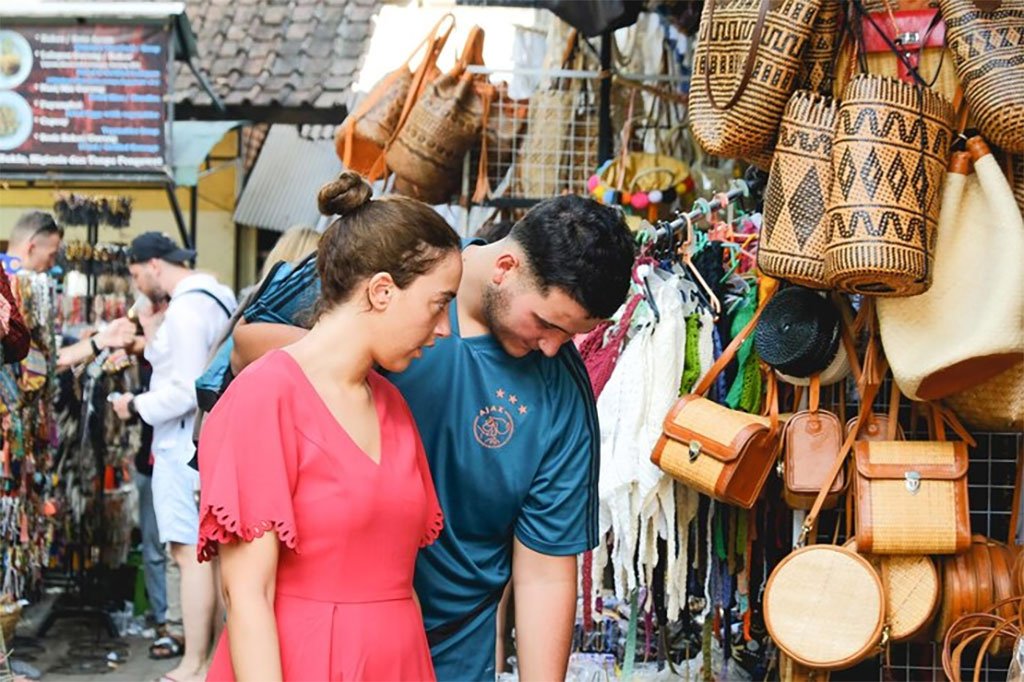From Market to Suitcase: 15 Must-Have Bali Souvenirs You Can’t Leave Without
Bali is a sensory paradise: the scent of incense drifts through temple courtyards, the vibrant colors of handwoven textiles blur together, and... Read More

Bali is not only known for its breathtaking beaches and serene temples but also for its vibrant traditional markets that brim with color, culture, and local character. Exploring these bustling hubs offers an authentic glimpse into daily Balinese life. From handwoven baskets and fresh spices to sacred offerings and local textiles, every item tells a story of tradition, craftsmanship, and community.
In this ultimate guide, we’ll journey through Bali’s most iconic markets, decode the cultural significance behind them, and give you practical tips to navigate and shop like a local.
Traditional markets in Bali—called pasar tradisional—are more than just places to shop. They are social epicenters where locals gather at the break of dawn to sell produce, gossip, and make ceremonial preparations. These markets have been part of Balinese society for centuries, forming a key aspect of the island’s economic and spiritual life.
Markets operate daily, usually in two shifts: morning for fresh produce and food, and evening for handicrafts and textiles. The shift in rhythm showcases the adaptability of these marketplaces to serve both locals and tourists alike.
Located in the heart of Bali’s cultural capital, the Ubud Art Market is a must-visit. Known locally as Pasar Seni Ubud, this market showcases handcrafted goods made by artisans from nearby villages.
📝 Tip: Visit early in the morning when it’s cooler and less crowded. Bargaining is expected, so don’t shy away from negotiating.
A sensory overload in the best way, the Gianyar Night Market (Pasar Senggol Gianyar) is a local favorite where street food is king. This is where the real flavors of Bali come alive.
📝 Tip: Bring small change and don’t wear your best clothes—it’s going to get messy and delicious!
For those in search of souvenirs that scream authentic Bali, Sukawati Art Market is a haven. It has been around for decades and is famous for affordable art and traditional items.
📝 Tip: Take your time. The market is large and packed with treasure if you dig deep enough.
In the heart of Bali’s capital city, Kumbasari Market offers a more local vibe. Spread across multiple floors, it features an eclectic mix of offerings—from daily needs to spiritual items.
📝 Tip: Visit early for cultural observation and late for discounted goods.
Just across the river from Kumbasari, Pasar Badung is Bali’s largest traditional market. It’s a sensory explosion where vendors call out prices and haggle over kilos of fruit and rice.
📝 Tip: Bring a reusable bag and wear closed shoes—the floor can be wet and slippery.
Often overshadowed by Sukawati, Guwang Market is a less crowded alternative with similar offerings. Its hidden gem status means prices are sometimes even lower.
📝 Tip: Ask about the origin of the artwork; many vendors are family members of the artists.
Away from touristy areas, Tabanan Market is as local as it gets. It’s chaotic, vibrant, and refreshingly raw. Think muddy paths, bargaining grandmothers, and the scent of incense in the air.
📝 Tip: Don’t expect English. Learn a few Balinese words—it goes a long way.
Situated in Klungkung Regency, this market is known for its blend of traditional wear and culinary diversity. It’s a great stop if you’re heading east toward Amed or Candidasa.
📝 Tip: Pair a market visit with a trip to the nearby Kertagosa Palace for a cultural double-whammy.
Besides daily markets, Bali also has weekly pop-up markets and specialty bazaars aimed at both locals and expats.
📝 Tip: Follow local expat forums or Facebook groups to find out about these events.
When shopping in Bali’s traditional markets, showing respect goes a long way. Here are a few dos and don’ts:
Shopping at traditional markets isn’t just about getting good deals. It supports local families, preserves culture, and reduces the carbon footprint associated with imported goods.
When you buy that hand-carved mask or intricate sarong, you’re not just getting a souvenir—you’re taking home a piece of Bali’s soul.
Customs laws vary, but most handcrafted goods and non-perishable foods are safe to bring back. Just remember:
📝 Tip: Ask vendors to wrap items securely. Many will happily help you prep your souvenir for the journey.
Whether you’re a foodie, an art lover, or a culture buff, Bali’s traditional markets offer something for everyone. Beyond the trinkets and textiles, they offer a window into the heartbeat of Balinese life—colorful, chaotic, and incredibly beautiful.
Take your time, engage with the people, savor the food, and let your senses guide you. There’s no better way to connect with the essence of Bali than by wandering its vibrant markets.
Join The Discussion